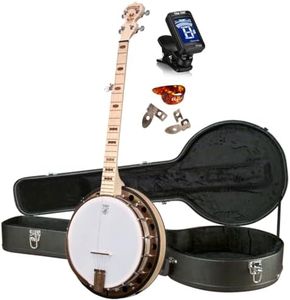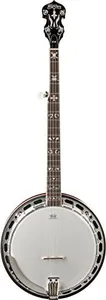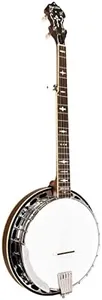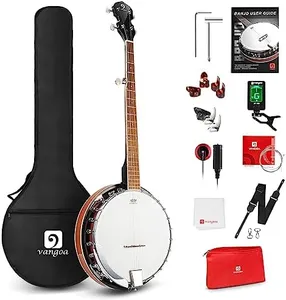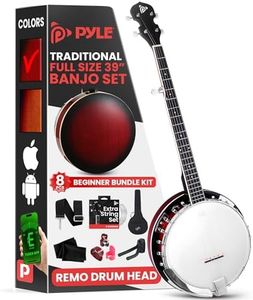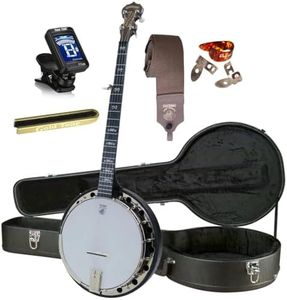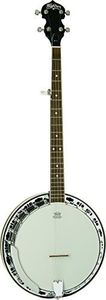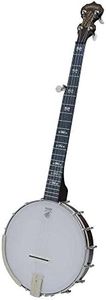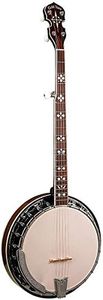10 Best Banjos 2025 in the United States
Our technology thoroughly searches through the online shopping world, reviewing hundreds of sites. We then process and analyze this information, updating in real-time to bring you the latest top-rated products. This way, you always get the best and most current options available.

Our Top Picks
Winner
Deering Goodtime 2 5-String Maple Resonator Bluegrass Banjo 1920's Art Deco Inlay Bronze Powder Coat Hardware with Instrument Alley Hard Case Combo
The Deering Goodtime 2 is a 5-string resonator banjo designed with bluegrass players in mind, featuring a maple neck and a 3-ply maple/poplar resonator rim that helps produce a bright, focused sound typical of this style. Its neck has a comfortable 'D' shape with 22 nickel silver frets, which gives you plenty of room to play, and a standard 1 1/4" nut width that feels familiar to most players. The resonator design means the banjo projects well and has a louder, punchier tone compared to open-back models, making it a great option for stage or jam sessions where volume and clarity matter.
Weighing around 6.5 kg (14 lbs), it’s a bit on the heavier side, which is common for resonator banjos, so some players might find it less comfortable for long playing sessions. The instrument includes features like a 3-ply poplar resonator with a 13 7/8" diameter, a high crown frosted head for bright tone, and bronze powder-coated hardware which adds durability and stylish looks. It also comes with a hard case, which is a nice bonus for protection and transport.
While its price places it in the mid-range category, the quality of materials and craftsmanship from Deering—made in the USA—makes it a trustworthy choice for beginners wanting a serious instrument or for intermediate players looking for a reliable, great-sounding banjo. If you prefer a lighter banjo with a mellower tone, you might want to explore open-back models instead, but for bluegrass and louder playing styles, this banjo performs very well.
Washburn Americana Series B16K-D 5 String Banjo Sunburst
The Washburn Americana Series B16K-D is a 5-string banjo designed with a maple resonator and rim, giving it a bright, full sound that suits bluegrass and other traditional styles well. Its maple neck and flame maple back offer sturdy construction and a polished tobacco sunburst finish that looks appealing. Equipped with a Remo banjo head and an ebony-tipped maple bridge, it delivers clear, crisp tones with good articulation.
The included planetary chrome tuners allow for smooth and stable tuning, which is great for beginners and intermediate players. Weighing around 9 pounds, it’s a bit on the heavier side, typical for resonator banjos, which might affect comfort during long playing sessions. The 28-inch scale length and ebony fretboard provide a familiar feel and good playability. The chrome armrest adds extra comfort, a nice touch for extended use.
This banjo is a solid pick for those looking for a resonator banjo with balanced sound and reliable build, although the heavier weight could be a consideration depending on personal playing style and needs.
Gold Tone OB-150: Orange Blossom Banjo with Case, 5-String Banjo
Most important from
14 reviews
The Gold Tone OB-150 is a well-crafted 5-string banjo that stands out for its resonator design, making it a solid choice for those interested in bluegrass or folk music. The 11" brass flat top tone ring and 3-ply maple rim contribute to a rich, bright sound, ideal for projecting in ensemble settings. With a scale length of 26-1/4", it caters well to both beginner and intermediate players looking for playability without sacrificing tone quality. The fingerboard made of rosewood offers a smooth feel, enhancing playability.
One of the key strengths of the OB-150 is its build quality. The one-piece cast flange and solid maple construction provide durability and stability, while the engraved armrest adds a touch of elegance. Weighing in at about 11.48 pounds, it is reasonably lightweight, making it manageable for longer playing sessions.
There are a few considerations to keep in mind. As a resonator banjo, it may not be as suitable for players looking for a softer, more mellow tone that open-back models provide. Some users might find the satin finish less appealing if they prefer a more glossy look. Additionally, while the banjo's weight is manageable, it may be slightly heavy for absolute beginners or younger players.
Most important from
14 reviews
Buying Guide for the Best Banjos
Choosing the right banjo can be a rewarding experience, whether you're a beginner or an experienced player. The key to finding the perfect banjo is understanding the different specifications and how they align with your playing style, musical preferences, and skill level. By focusing on the key specs, you can make an informed decision that will enhance your playing experience and help you achieve your musical goals.FAQ
Most Popular Categories Right Now
